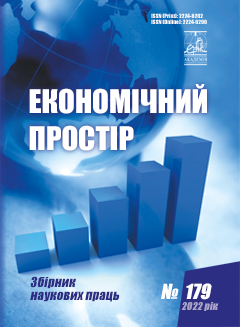SPATIAL IMBALANCES OF SLOVAKIA: DEVELOPMENT POLES AND PERIPHERAL TERRITORIES
Abstract
The paper is devoted to the research of spatial disbalances in Slovakia: particularly the aspects of growth/development poles and peripheries. The concept of spatial poles and axes runs back to 1950s and currently it is getting a new spark of interest (after few decades of mixed success implementation in some states). The main idea of the concept is that economic growth is not uniform in different territories but is concentrated in so-called poles, and then it spreads via diverse channels (axes) through the other regions. However, OECD reports show two clear trends: (1) the share of national and international economic growth generated outside major urban hubs ranges from 70 to 80%; (2) today, the regions that are growing most dynamically in most countries are not large cities, but other types of regions, some of which are typically peripheral. Currently some regions in the Europe could be marked as of advanced dynamic development – visually they could be grouped as “Red Octopus” (farther development of the ideas of “Blue Banana”, “Sunny Belt”, “Blue Pentagram”). Nowadays, Slovakia (especially its western regions) is situated on one of the “limbs” of such “Octopus”. However, the eastern part of the country is traditionally considered as European periphery. This makes the paradigm of poles & axes to be very important for the country’s farther progress. There is also an interest to develop the new cross-border axis: Wien (Austria)–Bratislava–Kosice–Uzhhorod/ Mukachevo (Ukraine). Large share of Slovak territory is considered as peripheral in pan-European researches. Nevertheless, a great progress is observed in this field during last decades. Particular improvements are detected considering the GDP per capita growth, unemployment shrinking, public welfare. Slovakia is among few states that included strategy of ‘poles’ and ‘axes’ development in their official spatial program. Taking into account that territorial development and infrastructure issues had been under the control of single Ministry, this provides additional synergy to the growth poles approach. It should be noted that approach combined both global tendencies adapted to local peculiarities of the regional development and could be considered as good example of glocalization strategy. Thus, Slovak experience could be essential for Ukraine taking into account problems with polycentric and balanced regional development.
References
Marošević K., Bošnjak D. Regional development and glocalisation: Theoretical framework. Econviews – Review of Contemporary Business, Entrepreneurship and Economic Issues. 2018. No. 31(1). P. 201-213.
Koopmans M. E., Rogge E., Mettepenningen E., Knickel K., & Šūmane S. The role of multi-actor governance in aligning farm modernization and sustainable rural development. Journal of rural studies. 2018. 59, 252-262. DOI: 10.1016/j.jrurstud.2017.03.012
De Toni A., Vizzarri M., Lasserre B., Carrosio G., Sallustio L., and Di Martino P. Inner peripheries: dealing with peripherality and marginality issues within the European policy framework. TERRA: Revista de Desarrollo Local, 2020. 24-47(7). DOI 10.7203/terra.7.17239.
Kostiukevych R., Mishchuk H., Zhidebekkyzy A., Nakonieczny J., & Akimov O. The impact of European integration processes on the investment potential and institutional maturity of rural communities. Economics and Sociology, 2020. 13(3), 46-63. DOI:10.14254/2071-789X.2020/13-3/3.
OECD. Regions and Cities at a Glance, 2018. URL: https://www.oecd-ilibrary.org/governance/oecd-regions-and-cities-at-a-glance-2018_ reg_cit_glance-2018-en
ESPON. PROFECY – Inner Peripheries: National territories facing challenges of access to basic services of general interest. 2020. URL: https://www.espon.eu/inner-peripheries
Ліщинський І. О. Полюси та осі розвитку в контексті глокалізаційних процесів: монографія. Тернопіль: ТНЕУ, 2019. 364 с.
Slovak Spatial Development Perspective, 2011. URL: https://www.mindop.sk/ministerstvo-1/vystavba-5/uzemne-planovanie/dokumenty/
slovak-spatial-development-perspective
Marošević K., Bošnjak D. (2018) Regional development and glocalisation: Theoretical framework. Econviews – Review of Contemporary Business, Entrepreneurship and Economic Issues, no. 31(1), pp. 201-213.
Koopmans M. E., Rogge E., Mettepenningen E., Knickel K., & Šūmane S. (2018). The role of multi-actor governance in aligning farm modernization and sustainable rural development. Journal of rural studies, 59, 252-262. DOI: 10.1016/j.jrurstud.2017.03.012
De Toni A., Vizzarri M., Lasserre B., Carrosio G., Sallustio L., and Di Martino P. (2020). Inner peripheries: dealing with peripherality and marginality issues within the European policy framework. TERRA: Revista de Desarrollo Local, (7), 24-47. DOI 10.7203/terra.7.17239.
Kostiukevych R., Mishchuk H., Zhidebekkyzy A., Nakonieczny J., & Akimov O. (2020). The impact of European integration processes on the investment potential and institutional maturity of rural communities. Economics and Sociology, 13(3), 46-63. DOI:10.14254/2071-789X.2020/13-3/3.
OECD (2018). Regions and Cities at a Glance, 2018. URL: https://www.oecd-ilibrary.org/governance/oecd-regions-and-cities-at-a-glance-2018_ reg_cit_glance-2018-en
ESPON (2020). PROFECY – Inner Peripheries: National territories facing challenges of access to basic services of general interest. URL: https://www.espon.eu/inner-peripheries
Lishchynskyy I. O. (2019) Poliusy ta osi rozvytku v konteksti hlokalizatsiynykh protsesiv: monohrafiya (Poles and axes of development in the context of glocalization processes). Ternopil: TNEU
Slovak Spatial Development Perspective, 2011. URL: https://www.mindop.sk/ministerstvo-1/vystavba-5/uzemne-planovanie/dokumenty/
slovak-spatial-development-perspective



